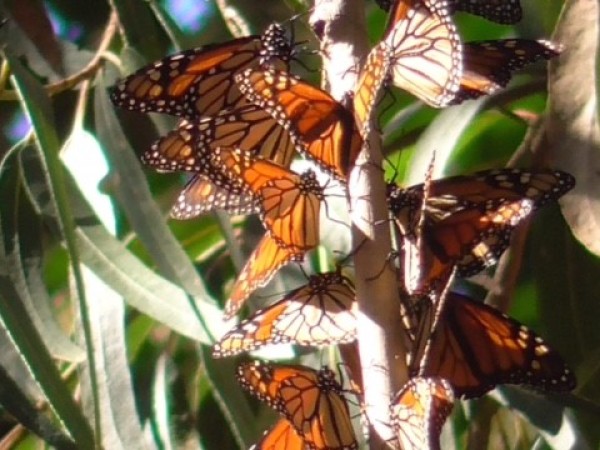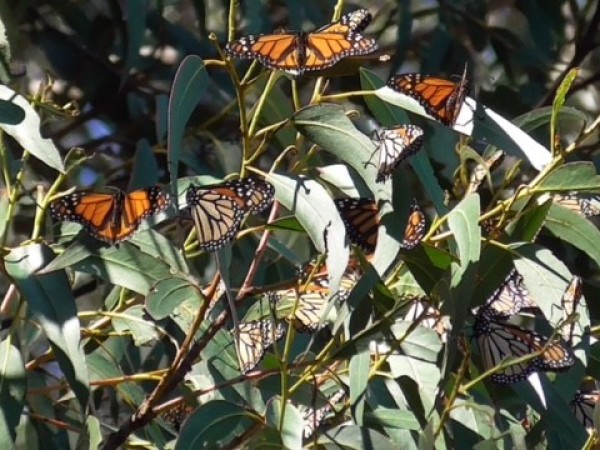Letter From Gail Morris: Western Monarch Fall 2022 Report #3
Published: 10/11/2022
Dear Western Monarch Friends,
Monarch sightings expanded over most of the West this week, especially through gateways into California to the overwintering sites. Arizona had several sightings as well with some monarchs likely on their way to Mexico. Earlier years maps were often void of sightings in the West, but this year more and more monarchs were reported during this critical time of the annual fall migration. Be sure to look at the Adult Sightings map to see the wide range and abundance of sightings throughout the entire region. But not all monarchs in California may be migrating, especially in the Southern border regions. Thanks to everyone who helped make this mapping possible!
Monarchs arriving at the California Overwintering sites!
“They’re back!” Several of the overwintering sites now have monarchs arriving at their winter homes and volunteers are eagerly counting their progress.
Pacific Grove Update
Stephanie Turcotte has been looking for monarchs. “I thought I’d check in to let you know that I have been checking the Pacific Grove monarch habitat for this year’s first overwintering residents; however, as of yet we have only had a few fliers on the coast (I’ve seen 6 max) and one individual monarch nectaring on Friday. Last season, we didn’t begin counting clusters until Oct. 16th. That’s not that far away and there are fewer flying through the area than last season. It will be VERY interesting to see what happens here in the coming weeks. I will keep checking and let you know when we get our first count.”
Natural Bridges State Beach & Lighthouse Field
Further north and just across the bay, Diana Magor is finding monarchs already forming clusters! Diana shares her monitoring reports for us to get a sense of their activity.
“It was the annual Monarch Festival today (Sunday, 10/9), so much too crowded for me to count, but Bob estimated 3x more than last Tuesday. Bob and his wife Clemencia were just here today (she’s a docent there and was helping out). It was a great event, with lots of really good info and zillions of people, including little kids all dressed up in monarch outfits! So cute!”
Diana sent several earlier reports. “I observed an estimated 55 monarchs at Natural Bridges State Beach on 9/28/22 at 9:00am. About 40 were nectaring on Ivy flowers in the sun, 10 flying above the Eucalyptus trees and 5 on the upper meadow. Temp about 60F. Fog moving in at 9:20.”
“Dorothy Pedersen observed 3 clusters totaling 33 monarchs at Lighthouse Field on 9/26/22, and has seen more (estimated in the 40’s) flying into and around the sanctuary around 4:30 pm since then, but not clustering.”
“Had 1 female at my Scott’s Valley Waystation (5 miles inland from Santa Cruz) nectaring on Tithonia rotundifolia on 9/15/22. I also observed for the first time 2 monarchs (1 male, 1 female) nectaring for more than an hour on the flowers of a strawberry tree (Arbutus unedo) in my garden on the West side of Santa Cruz. 9/27/22. Lots of monarchs in Santa Cruz.”
“Lighthouse Field, 10/2/22, 4:30pm. I observed 61 monarchs clustering on the East side of the sanctuary. Many were already there, with others coming in. 2 clusters near each other. Sunny, about 67F, stiff West breeze."
“Dorothy’s sightings of up to 49 last week confirmed.:
9/26 33 in 3 clusters
9/27 41 no clusters
9/28 49 no clusters
9/29 46 no clusters
“I see them daily in my garden if it’s sunny from 8:30am to 6:30pm. We had a foggy couple of days Sat & Sun. This may contribute to the monarchs clustering in the overwintering sites. Sun was out & it was warm Sunday afternoon.”
On Tuesday, October 4, Diana found a big jump in the numbers of monarchs arriving.
“New count at Natural Bridges this a.m.: 285, of which 230 were in 4 clusters in shade, 40 were nectaring in sun on Ivy flowers and approx 15 were flying or sunning at the Upper Meadow. Cool (60F), sunny, no wind.”
A special Thank You to Stephanie Turcotte and Diana Magor for their reports and Robert Pacelli for his exciting photos at Natural Bridges. It will be exciting to see what new activity the upcoming weeks will bring!
Night Roosts?
Keep an eye out for small numbers of monarchs in trees. In the West, the number of monarchs may be small, sometimes only 4 or 6 in close proximity. Usually, you can find them on the Southeast side of a tree, especially if there is nectar nearby. Monarchs know that the morning sun can warm them up easily in this location and they can feed before continuing their migration. Let us know if you see them and be sure to take a photo! Often you may see several groupings of 4-6 monarchs or more. Have fun looking!
Send in your reports!
If you are out this week and see monarchs of any life stage, be sure to report them to Journey North—whether they are adults or eggs or larvae. Provide as much information as you can such as weather conditions (it’s okay to estimate). Your detailed description of what you see can include, but is not limited to, the monarch’s gender and activity and, if known, the type of flowers if they are nectaring.
Gail Morris is the Coordinator of the Southwest Monarch Study (www.swmonarchs.org), a Monarch Watch Conservation Specialist, and the Vice President of the Monarch Butterfly Fund, the Central Arizona Butterfly Association and the Western Monarch Advocates. The Western Monarch Population News is based on comments provided to Gail Morris. We hope to increase the number of sightings and therefore photos and comments entered into Journey North. We rely on the volunteers who communicate regularly with Gail and who agree to participate in our effort to increase awareness of the population of western Monarchs. You can reach her at gail@swmonarchs.org




